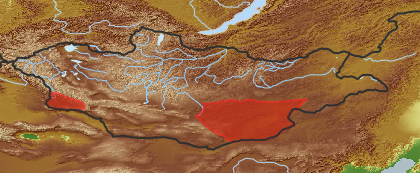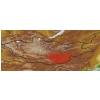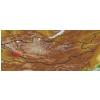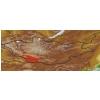| Class: | angiosperms |
| Order: | Caryophyllales |
| Family: | Molluginaceae |
| Genus: | Mollugo |
| Scientific name: | Mollugo cerviana (L.) Ser. |
| Name acc. to: | Gubanov 1996 |
| Herbar: | list records    |
| Synonym: | Aizoaceae M. cerviana (L.) Ser. (acc. to Grubov 1982) |
| Link to Flora of China: | http://www.efloras.org/browse.aspx?flora_id=2&name_str=Mollugo+cerviana |
| open map in a new window |  |
| Habitat: | Sandy and sandy-pebble bottom of sayrs (Grubov 2001). |
| Habit (i)general appearance of a plant | |
| Growth form: (i)Herb, shrub, tree or climber. | annual (i)Completing its life cycle within one year or one growing season; roots weak and thin
herb (i)Herbaceous, erect plant, up to 2m high, mostly with a leafy shoot; if perennial, shoots die to the ground each season, shoots are not woody
example: Artemisia pectinata 
|
| Size of plant: (i)Attention: use flowering or fruiting specimens to assess plant height (many biennial plants possess only a basal rosette in the first year). | to 100 mm
|
| Parasite status: (i)Is the plant a half- or full parasite? | no parasite/saprophyte (i)Plant fully autonomous, leaves with chlorophyll
example: Most plants, Ranunculus  inherited by family Molluginaceae: no parasite/saprophyte inherited by family Molluginaceae: no parasite/saprophyte
|
| Water or terrestrial plant: (i)Where do the plants grow? | terrestrial (i)Plant grows on dry land
example: Orostachys spinosa
|
| Leaf (i)expanded, usually photosynthetic organ of a plant (including phylloclades) | |
| Leaf development: (i)Structure and development of leaves. | with green leaves (i)Plant with green leaves  inherited by family Molluginaceae: with green leaves inherited by family Molluginaceae: with green leaves
fleshy leaf (i)Leaves more or less thick, juicy, terete or flat
example: Crassulaceae
|
| Leaf arrangement: (i)Arrangement of leaves at the stem. | opposite, opposite-decussate (i)Two leaves per node
example: Lamiaceae, e.g. Phlomis    inherited by family Molluginaceae: opposite, opposite-decussate inherited by family Molluginaceae: opposite, opposite-decussate
whorled or fascicled (i)Three or more leaves per node or leaves crowded.
example: Galium, Nitraria   inherited by family Molluginaceae: whorled or fascicled inherited by family Molluginaceae: whorled or fascicled
basal rosette (i)Leaves positioned at the base of the stem; stem often without leaves, no visible internodes (but flowers often on erect stems, and these may have few leaves)
example: Limonium, Potentilla, Plantago; also used in Liliales with basaly crouwded leaves (Tofieldia, Zigadenus etc.) 
|
| Simple or divided leaves: (i)Are the leaves simple or completely divided in several parts? Blade of the leaf entire or (more or less) deeply dissected. Attention: There are various appearances of the leaf margin (from entire to toothed and lobed). Here, we ignore this and ask only for dissections that separate the leaf for more than one third of its length or width, whatever is smaller. Sometimes, it is difficult to tell apart compound leaves from a shoot system with simple leaves: look for stipulae and/or axillary buds at the ground of the leaves: if only some possess these structures, the others are most likely leaflets of a compound leaf. | simple (i)Non-divided leaf, but margin may be incised nearly to the ground   inherited by family Molluginaceae: simple inherited by family Molluginaceae: simple
|
| Shape of blade: (i)Easy for simple leaves. In compound leaves use the general shape of leaflet. Always check the ground for largest leaves of a plant. To be worked out: how to handle pinnate leaves? | linear incl.grasslike or oblong (i)Leaves more than two times longer than broad with more or less parallel margins; see character: stipule for ligula
example: Dracocephalum ruyschiana, Poaceae, Scutellaria scordifolia, Pinus   inherited by family Molluginaceae: linear incl.grasslike or oblong inherited by family Molluginaceae: linear incl.grasslike or oblong
|
| Length of leaves: (i)How long is the leaf, be carefull in compound leaves, measure the complete leaf. | to 5 mm
from 6 mm to 10 mm
|
| Width of leaves: (i)How broad is the leaf, be carefull in compound leaves, measure the complete leaf. | -1 mm
|
| Leaf apex: (i)Appearance of the tip of leaf resp. leaflets in compound leaves. | acuminate (i)Gradually tapering to a (sharp) point
example: Populus laurifolia? 
|
| Leaf margin: (i)Structure of leaf margin (or that of a leaflet in case of compound leaves). Attention: Here we ask for the leaf margin, defined as all those dissections that separate the leaf for less than one third of its length or width, whatever is smaller. To be worked out: how to handle margin of pinnate leaves? | entire (i)Plain margin, not toothed
example: Iris   inherited by family Molluginaceae: entire inherited by family Molluginaceae: entire
|
| Petiole: (i)Leaf divided into stalk (petiole) and blade. | without (i)Leaves without petiole (stalk), sessile
example: Poaceae, Iris   inherited by family Molluginaceae: without inherited by family Molluginaceae: without
|
| Leaf colour upper side: (i)Shades of green on the leaf, upper side. | green (i)Clear green
example: Tribulus terrestris
grayish (i)Grayish in colour due to hairs or a thick cuticula
|
| Leaf colour lower side: (i)Shades of green on the leaf, lower side. | green (i)Clear green, in most species
example: Angelica decurrens
grayish (i)Grayish in colour due to hairs or a thick cuticula
example: Atriplex cana
|
| Leaf veination: (i)Arrangement of the main veins of a leaf. | pinnate (i)One main vein, several side veins, sometimes inconspicuous
example: Cicerbita     inherited by family Molluginaceae: pinnate inherited by family Molluginaceae: pinnate
|
| Flower (i)reproductive portion of the plant, consisting of sepals, petals, stamens, and pistils | |
| Flower appearance and pollination: (i)General appearance of the flower. | attractive, animal-pollinated (i)attractive and coloured flowers, mostly large, attracting surely animals
example: Trollius, Rosa, Chamaerhodos
|
| Flower colour: (i)Attention: assess colour of the most colourful parts of the flower, but not of the stamens; be aware of single plants with a mutation (mostly white) on flower colour. | greenish (i)petals absent or not distinctly different from colours of leaves, only stigmas (white) or anthers (yellow) may differ in color
example: Chenopodium, Triglochin
white (i)Most plants of the population white
example: Pleurospermum, Maianthemum
|
| Perianth arrangement: (i)Attention: in some plants, flowers may be dimorphic in different ways (dioecious or gynodioecious). If flowers vary, record the characters of the most showy flowers. | simple, similar (i)Only one type of perianth leaves (tepals)
example: Tulipa 
|
| Diameter of flower: (i)Diameter of flower or flower head. | to 5 mm (i)
example: Aruncus
|
| Length of flower: (i)For zygomorphic flowers only, instead of diameter of flower. | to 10 mm
|
| Flower symmetry: (i)Symmetry of the perianth leaves. Attention: to assess this character, look on sepals, petals and stamens, but neglect carpels and ovary. | radiary, regular (actinomorphic) (i)More than two axis of symmetry
example: Saxifraga: 5; Iris: 3 
|
| Flower form: (i)common forms of flowers ? Veronica | simple (flat) - Do not confuse with inflorescences as in some Asteraceae (i)Petals spread out, flower appearing flat
example: Mollugo, Trientalis, Pulsatilla, Saxifraga   inherited by genus Mollugo: simple (flat) - Do not confuse with inflorescences as in some Asteraceae inherited by genus Mollugo: simple (flat) - Do not confuse with inflorescences as in some Asteraceae
|
| Petal / Tepal number: (i)Number of petal leaves (inner perianth leaves, usually coloured). | 5 (i)
example: Potentilla
|
| Petal / Tepal fusion: (i)To which degree are the petal leaves connected? Petals sympetalous. | free (i)all petal leaves separate from each other
example: Anthriscus
|
| Spur: (i)A hollow, slender, sac-like appendage of the perianth leaves, storing nectar. | no spur (i)Flower without appendage
example: Peganum
|
| Stamen number: (i)Attention: We ask for the reproductive organs of the flower dispersing pollen. Count only fully fertile stamens, not staminodia (e.g. Parnassia). | 3 (i)
example: Poa, Iris
4 (i)Extremely rare, may be absent
example: Plantago
5 (i)
example: Peucedanum
|
| Stamen fusion: (i)To which degree are the stamens fused? Attention: Whereas the pollen sacs itself are often free., their stalks (filaments) may be fused. Here, we count them as fused if they are together over at least one thirth of their length. | free (i)Stamens with separate bases
example: Malus
|
| Pistil number: (i)Number of pistils (female floral organs: style, if developed; stigma and carpels/ovary together build the pistil). | 1 (i)One carpel, but clearly one stigma
example: Pyrola, Primula, Alyssum
|
| Carpel number: (i)Number of carpels (carpel: forming a simple pistil or part of a compound pistil, modified leaf). | 3
|
| Carpel fusion: (i)To which degree are the carpels (modified leaf forming simple pistil or part of a compound pistil) fused. | fused (i)Carpels united into an ovary, only styles are free
example: Malus, Berberis
|
| Style number: (i)Portion of the pistil connecting the stigma to the ovary. | 3
|
| Ovary position: (i)For entirely or partly fused carpels, describe their position in relation to the insertion point of perianth leaves (best done by doing a longitudinal section of a flower). | superior (hypogynous) (i)Base of carpels attached above insertion point of perianth leaves, carpels free or fused
example: Delphinium, Anemone  
|
| Sex: (i)Distribution of male and female organs among flowers, only most commonly cases. | bisexual, hermaphrodite (i)All or nearly all flowers of a plant with male and female parts
example: Haplophyllum, Chenopodium
|
| Inflorescence (i)flowering part of a plant, describes the arrangement of the flowers on the flowering axis | |
| Inflorescence: (i)Structure of the inflorescence. | Flowers in inflorescence (i)No solitary flowers
|
| Appearance: (i)Outer look of the inflorescence. | terminal (i)Inflorescence is the highest point of the plant and may consist of a single flower only
example: Cypripedium, Rhaponticum, Ligularia sibirica, Echinops
axillary (i)Usually several inflorescences in axillary shoots or single flowers in leaf axils, main shoot remains mostly leafy
example: Tragopogon, Aconogonon
|
| Inflorescence type: (i)Types of inflorescence. Attention: We here ask for the botanical nomenclature of inflorescences, which is sufficiently complicated. Tick only, if you are certain, or tick all inflorescence types that appear similar of these of the plant in question. | umbel (i)Flowers on short to long, leafless stalks emerging from one point
example: Allium 
cyme (i)A branched inflorescence, where the main shoot soon ends in a flower, being overtopped by one ore more shoots; attention: the flowers are often very crowded and the type difficult to identify (Lamiaceae)
example: Lamiaceae, Caryophyllaceae, Mollugo cerviana, Panzerina 
|
| Fruit (i)the seed bearing organ, with or without adnate parts; a ripened ovary and any other structures which are attached and ripen with it. Aggregate fruits are handled like simple fruits for determination. | |
| Consistency: (i)Fleshy fruits or dry fruits, see dispersal adaptations for further classification. | dry (i)With a dry outer shell, no fleshy parts, but seed (embryo) could be edible
|
| Type of fruit: (i)Common fruit types (including pseudocarp). | Solitary fruits (i)   
capsule (i)Dry dehiscent fruit, releasing seeds by slits or holes.
example: Poppy, most Caryophyllaceae, Cerastium, a lot of Scrophulariaceae, Iris (oppened capsule looks like Delphinium), Zygophyllum - it is a very common fruit type   
Dehiscent fruits (i)Fruits open along a longitudinale line (except silicula)
|
| Size of fruit: (i)Size of the fruit including appendage. | to 5 mm (i)
example: Halerpestes: many folicles forming dry nutlets
|
| Root / shoot below ground (i)plant part below ground (in most cases), including below ground shoots, without leaves | |
| Root type: (i)Organisation of the roots. | allorhizous (i)Plant with a conspicuous tap root, one larger tap root with side roots
example: Dicotyledonae  inherited by order Caryophyllales: allorhizous inherited by order Caryophyllales: allorhizous
|
| Distribution (i)region where the plant is likely to be found | |
| Distribution (Veg. Zones): (i)acc. to Grubov 1952 | East Gobi (i)In distribution data often named as '12' 
Dzungarian Gobi (i)In distribution data often named as '14' 
Transaltai Gobi (i)In distribution data often named as '15' 
|